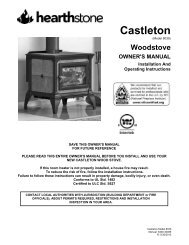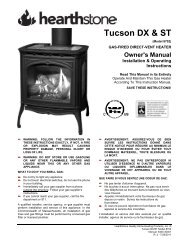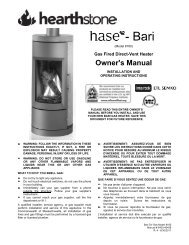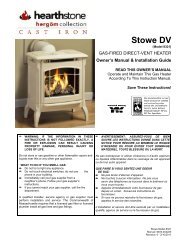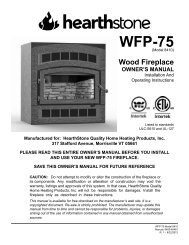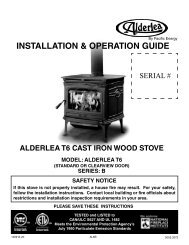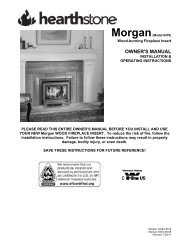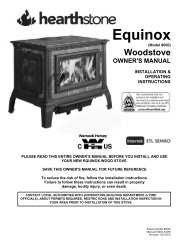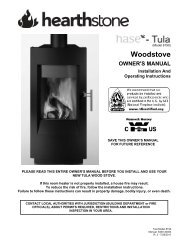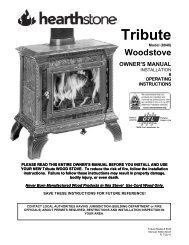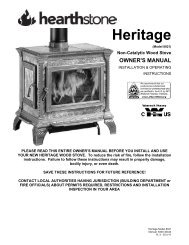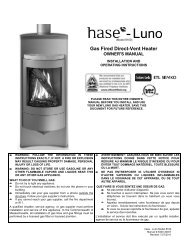summit manual pdf - The Chimney Sweep Online
summit manual pdf - The Chimney Sweep Online
summit manual pdf - The Chimney Sweep Online
You also want an ePaper? Increase the reach of your titles
YUMPU automatically turns print PDFs into web optimized ePapers that Google loves.
IMPORTANT:THESE INSTRUCTIONS ARE TOREMAIN WITH THE HOMEOWNER.PLEASE SAVE THESE INSTRUCTIONS.SERIAL #SAFETY NOTICEIf this stove is not properly installed, ahouse fi re may result. For your safety,follow the installation instructions. Contactlocal building or fire officials aboutrestrictions and installation inspectionrequirements in your area.INSTALLATIONAND OPERATINGINSTRUCTIONSTESTED and LISTED to CAN/ULC S627AND UL 1482Meets the Environmental ProtectionAgency's July 1990 Particulate EmissionStandardsMODEL:SUMMITSUMMIT CLASSICSERIES-B190112-20 SUMMIT-B 5055.3252
ContentsNOTE:WE STRONGLYRECOMMEND THATSMOKE DETECTORS BEINSTALLED.If smoke detectors have been previouslyinstalled, you may notice thatthey are operating more frequently.This may be due to curing of stovepaint or fumes caused by accidentallyleaving the fi re door open. Do notdisconnect the detectors. If necessary,relocate them to reduce theirsensitivity.SAFETY NOTICE:If this stove is notproperly installed,a house fire mayresult. For your safety,follow the installationinstructions. Contactlocal building orfire officials aboutrestrictions andinstallation inspectionrequirements in yourarea.Please read this entire <strong>manual</strong> beforeyou install and use your new roomheater. Failure to follow instructionsmay result in property damage, bodilyinjury, or even death.Safety and Maintenance .............................................................. 3Creosote ....................................................................................... 4Formation and Need for Removal .......................................................... 4<strong>Chimney</strong> Fires ........................................................................................ 4In Case of a <strong>Chimney</strong> Fire ..................................................................... 4Avoiding a <strong>Chimney</strong> Fire ........................................................................ 4Assembly ...................................................................................... 5Crate Removal ....................................................................................... 5Pedestal Kit ............................................................................................ 5Black or Gold Leg Kit ............................................................................. 5Optional Ash Cleanout System .............................................................. 5Minimum Clearance to Combustibles ........................................ 5Single Wall Connector - Residential....................................................... 5Double Wall Connector - Residential ..................................................... 5Double Wall Connector - Mobile Home .................................................. 5Mobile Home Installation ............................................................ 6Clearances ............................................................................................ 6Procedure:.............................................................................................. 6Listed <strong>Chimney</strong> and <strong>Chimney</strong> Connector .............................................. 7Residential Installation ............................................................... 8Clearances ............................................................................................ 8<strong>Chimney</strong> and Connector ........................................................................ 8Double-Wall Connector .......................................................................... 8Single-Wall Connector ........................................................................... 8Procedure .............................................................................................. 8Floor Protector ............................................................................. 9Combustion Air ............................................................................ 9Operation .................................................................................... 10Wood Selection.....................................................................................10How to Test Your Wood .........................................................................10Lighting for the First Time .....................................................................10Lighting a Fire .......................................................................................10Normal Operation .................................................................................10Restarting After Extended or Overnight Burns ......................................10More Wood, More Heat .........................................................................11Proper Draft ..........................................................................................11Ash Removal ........................................................................................11Disposal of Ashes .................................................................................11Baffle Removal ............................................................................11Removal ................................................................................................11Secondary Air Box Removal and Cleaning: ..........................................11Appendix A ................................................................................. 12Troubleshooting ....................................................................................12Optional Blower ......................................................................... 12Blower Operation ..................................................................................12Optional Outside Air Adaptor ................................................................12Understanding & Operating Your Pacifi c Energy Stove .........................13Replacement Parts ...............................................................................14Replacement Parts - Summit Classic ...................................................15Pedestal or Legs Installation Instructions .............................................16Firebrick Installation Instructions ..........................................................17NOTES ........................................................................................ 18Label .....................................................................................................192 SUMMIT-B 190112-20
Safety andMaintenance1. Burn wood only, dry and well seasoned. <strong>The</strong> denser or heavierthe wood when dry, the greater its heat value. This is whyhardwoods are generally preferred. Green or wet wood shouldnot be used, as it will reduce heat output, as well as contributingsignifi cantly to creosote buildup.WARNING: Never use chemicals or any other volatile liquidto start a fire. Do not burn garbage, or flammable fluids suchas gasoline, naptha, or engine oil. We strongly recommendthat smoke detectors be installed.2. Remove ashes frequently. Embers can roll out the door andcreate a fi re hazard. Maintain a 1" minimum ash base.3. If glass becomes darkened through slow burning or poor wood,it can readily be cleaned with fi replace glass cleaner when thestove is cold. Never scrape with an object that might scratchthe glass. <strong>The</strong> type and amount of deposit on the glass is agood indication of the fl ue pipe and chimney buildup. A lightbrown dusty deposit that is easily wiped off usually indicatesgood combustion and dry, well-seasoned wood and thereforerelatively clean pipes and chimney. On the other hand, a blackgreasy deposit that is difficult to remove is a result of wet andgreen wood and too slow a burning rate. This heavy deposit isbuilding up at least as quickly in the chimney.6. <strong>The</strong> area where boost combustion air enters the fi rebox mustbe kept clear of excessive ash buildup which will block air flow.This area is at the front of the fi rebox.7. Do not store wood within heater installation clearances, or withinthe space required for fuel loading and ash removal. Keep thearea around the heater clean and free of loose combustibles,furniture, newspapers, etc.8. If gold door requires cleaning, use mild soap and water only.Use of abrasive cleaners will void warranty.9. Establish a routine for the fuel, woodburning and firing technique.Check daily for creosote buildup until experience shows howoften you need to clean to be safe.10. Be aware that the hotter the fi re, the less creosote is deposited.Weekly cleaning may be necessary in mild weather, even thoughmonthly cleaning is usually enough in the coldest months whenburning rates are higher.11. Instruct all members of your family on the safe operation ofthe heater. Ensure they have enough knowledge of the entiresystem if they are expected to operate it. Stress the section onchimney fi res and the importance of following the steps outlined"In Case of <strong>Chimney</strong> Fire".WARNING: ONLY USE MATERIALS AND COMPONENTSSUPPLIED OR SPECIFIED BY MANUFACTURER WHENDOING MAINTENANCE OR REPLACEMENTS.4. DOOR GASKETS - <strong>The</strong> gasket used by Pacifi c Energy (7/8"medium density fi berglass rope) requires only light pressureto seal. This will prolong seal life. It is important that the doorseal be maintained in good condition. Periodically inspect sealsand replace if necessary. Follow instructions included in theDR31.WDGKIT, kit obtainable from your nearest Pacifi c Energydealer.5. DOOR GLASS - Do not slam loading door or otherwise impactglass. When closing door, make sure that no logs protrude toimpact the glass. If the glass gets cracked or broken, it mustbe replaced before using the stove. Replacement glass canbe obtained from your dealer. Use 9-1/2" x 17-1/2" x 5 mm.Ceramic glass only. Do not substitute with any other type.To remove broken glass, undo the four retaining screws and removeclamps and frame, noting position for re-assembly. Remove allparticles of glass . Be careful as they are very sharp. Install newglass complete with gasket. Replace frame, clamps and screws.CAUTION:- do not overtighten, tighten screws very carefully- do not clean glass when hot- do not use abrasive cleaners on glassSUMMIT-B 190112-20 3
CreosoteFormation and Need for RemovalWhen wood is burned slowly, it produces tar and other organicvapours, which combine with expelled moisture to form creosote.<strong>The</strong> creosote vapours condense in the relatively cool chimney fl ueof a slow burning fi re. As a result, creosote residue accumulateson the fl ue lining. When ignited, this creosote makes an extremelyhot fi re. <strong>The</strong> chimney connector and chimney should be inspectedperiodically (at least once every two months) during the heatingseason to determine if a creosote buildup has occurred. If creosotehas accumulated (3 mm. or more), it should be removed to reducethe risk of a chimney fi re.1. Highest smoke densities occur when a large amount of woodis added to a bed of hot coals and the air inlet is closed. <strong>The</strong>heated wood generates smoke, but without ample air, the smokecannot burn. Smoke-free, clean burning requires small fuelloads, two or three logs at a time or 1/4 to 1/2 of fuel load andleaving the air inlet relatively wide open, especially during thefi rst 10 to 30 minutes after each loading, when most of the smokegenerating reactions are occurring. After 30 minutes or so, the airinlet can be turned down substantially without excessive smokegeneration. Wood coals create very little creosote-producingsmoke.2. <strong>The</strong> cooler the surface over which the wood smoke is passing,the more creosote will be condensed. Wet or green woodcontributes signifi cantly to creosote formation as the excessmoisture that is boiled off cools the fi re, making it difficult for thetars and gases to ignite, thus creating dense smoke and poorcombustion. This moisture-laden smoke cools the chimney,compounding the problem by offering the smoke the ideal placeto condense.In summary, a certain amount of creosote is inevitable and mustbe lived with. Regular inspection and cleaning is the solution.<strong>The</strong> use of dry, seasoned wood and ample combustion air willhelp to minimize the buildup.<strong>Chimney</strong> FiresIn Case of a <strong>Chimney</strong> Fire1. Prepare to evacuate to ensure everyone's safety. Have a wellunderstood plan of action for evacuation. Have a place outsidewhere everyone is to meet.2. Close air inlet on stove.3. Call local fi re department. Have a fi re extinguisher handy.Contact your local municipal or provincial fi re authority forfurther information on how to handle a chimney fi re. It is mostimportant that you have a clearly understood plan on how tohandle a chimney fi re.4. After the chimney fi re is out, the chimney must be cleaned andchecked for stress and cracks before starting another fi re. Alsocheck combustibles around the chimney and the roof.- <strong>The</strong> services of a competent or certified installer, (certified by theWood Energy Technical Training program (WETT) - in Canada,Hearth Education Foundation (HEARTH) - in U.S.A.,) are stronglyrecommended.Avoiding a <strong>Chimney</strong> Fire<strong>The</strong>re are two ways to avoid chimney fi res:1. Do not let creosote build up to a point where a chimney fi re ispossible.2. Do not have fi res in the heater that may ignite chimney fi res.<strong>The</strong>se are very hot fi res, such as when burning household trash,cardboard, Christmas tree limbs, or even ordinary fuel wood;(e.g.. with a full load on a hot bed of coals and with the air inletexcessively open.)NOTE: WHEN CLEANING THE CHIMNEY, ALWAYS COVER THEBAFFLE AIR TUBE THAT PROVIDES AIR TO THE BAFFLEAFTER YOU REMOVE THE BAFFLE.<strong>The</strong> result of excessive creosote buildup is a chimney fi re. <strong>Chimney</strong>fi res are dangerous. <strong>Chimney</strong> inside temperatures can exceed2000° F. This causes much higher than normal temperatures inthe chimney and on its exterior surfaces. Thus ignition of nearby ortouching combustible material is more likely during a chimney fi re.Proper clearances are critical during such a fi re.<strong>Chimney</strong> fi res are easy to detect; they usually involve one or moreof the following:-Flames and sparks shooting out of the top of the chimney-A roaring sound-Vibration of the chimney4 SUMMIT-B 190112-20
Mobile HomeInstallationWarning: Under no circumstances is this heater to be installed ina makeshift or "temporary" manner. It may be fi red only after thefollowing conditions have been met.- DO NOT CONNECT THIS UNIT TO A CHIMNEY FLUE SERVINGANOTHER APPLIANCE.- DO NOT INSTALL IN A SLEEPING ROOM.- Outside air supply must be used for Mobile Home installationssee Figure #3, Page 7.- <strong>The</strong> services of a competent or certified installer, (certified by theWood Energy Technical Training program (WETT) - in Canada,Hearth Education Foundation (HEARTH) - in U.S.A.,) are stronglyrecommended.ClearancesThis heater must be installed with listed double-wall connector andcompatible chimney system listed on page 7.Clearances to combustible surfaces and materials are shown inFigure #1 and Figure #3, page 5 and 7.Clearances may be reduced with various heat insulating materials.Consult local, National fi re codes and authorities for approval.NOTE: Longer chimney lengths and different pitch flashingsmay be used. All other parts listed must be installed (see Figure#3, Page 7). Install all components to the connector or chimneymanufacturer's installation requirements. Consult your chimneysupplier for installation advice.Procedure:CAUTION: THE STRUCTURAL INTEGRITY OF THE MOBILEHOME FLOOR, WALL AND CEILING/ROOF MUSTBE MAINTAINED.THE SPACE HEATER IS TO BE CONNECTED TO A FACTORY-BUILT CHIMNEY CONFORMING TO CAN/ULC-S629 STANDARDFOR 650C FACTORY-BUILT CHIMNEYS.Note: See "Combustion Air" section on page 9.1. Position stove and floor protection with hole for combustion airin accordance with the clearances as stated on the label andin Figure #1.2. Mark the position for the hole in the ceiling and roof by using astring and plumb-bob.3. Check that the intended location will not interfere with floor joists,ceiling joists or rafters before proceeding further.4. Cut a hole in the ceiling and roof to suit the chimney systemand frame in the sides. <strong>The</strong> chimney support is mounted to theframing.5. Assemble chimney sections so the fi nished length is resting onthe support and protruding through the roof. Avoid having jointsbetween ceiling and roof. Install radiation shield. Assembleflashing and storm collar and be sure to maintain the vapourbarrier at this point. (Seal securely.) Attach rain cap and checkflashing for leaks.6. Install connector as per manufacturer's instructions.7. Attach stove to flooring using two 1/4" x 2" or longer lagscrews.25 1/2" 27 7/8"23 1/2"8 1/2"Pacific Summit- Pedestal Model31 1/2"30"25 3/8"27 1/2"23 5/8"8 1/2"Summit Classic29"28 1/2"6 SUMMIT-B 190112-20
FIG. #3<strong>The</strong> chimney may incorporatean offset. To do this safely, allsections of listed connector,offset elbows and chimneysection must be screwedtogether by at least threesheet metal screws per joint.<strong>The</strong> chimney must be suitablysupported by the chimneymanufacturer's listed offsetsupport.Spark arrestorrain capRadiation shieldMinimum 7' (2.1m.)Ceiling Height3' (914 mm)Minimum54" (1372 mm)Minimum<strong>Chimney</strong>Storm collarRoof flashing<strong>Chimney</strong> Support<strong>Chimney</strong> Connector48"(1219 mm)Attachment to floor formobile homesNon-combustiblefloor protector* 4" diameter air inlet with rodent screen* If the crawl space is well ventilated it is notnecessary to extend air inlet to outsideHooded vent or90 elbow turneddownListed <strong>Chimney</strong> and <strong>Chimney</strong> ConnectorThis appliance, when installed in a Mobile Home, must be installed with:A. One of the following 6" double-wall connector systems:1. Security Model DL or DC 5. Metal Fab Model DW2. Oliver MacLeod Model PV 6. Ameri-Tec Model DBSP3. Energy Vent 7. Industrial <strong>Chimney</strong> Model Excel Ultra-Black4. Selkirk Metalbestos Model DS 8. Simpson Dura-Vent Model DVLB. As well as one of the following compatible chimney systems - All parts 6":CANADA ONLY: Security Pro-Jet ICC Selkirk Energy VentS2100 H.T.3000 Excel 2100 Sentinal CF Commander 5000Ceiling support XSF FCS SF CF-CSP CH6LCSRafter radiation shieldRRS3' <strong>Chimney</strong> length XL3 SL3 L3 CF-36SL CH6362' <strong>Chimney</strong> length XL2 SL2 L2 CF-24 CH624Roof flashing XFA RF17 FA CF-FRA CH6TCFStorm collar XSC SC SC CF-SC CH6SCSpark arrestor rain cap XCPE RCSA CPE CF-SA,CT CH6RC, SSUSA ONLY: Security Pro-Jet Security Pro-Jet Metalbestos MetalFab Ameritech ICC Simpson Dura-VentS2100 H.T.3000 ASHT HT3103 SSII 2100 TEC HS Excel 103HT Dura/Plus Dura TechCeiling support XSF FCS SF FCS T-SFA TGCSP 6PL-CS RDS/SQS SDP-SB SDP-SBRafter radiation shield RRS RRS T-JSMH TGRS3' <strong>Chimney</strong> length XL3 SL3 L3 SL3 T-36 TG3 HS 36 CL48 SDP-P SDT-P2' <strong>Chimney</strong> length XL2 SL2 L2 SL2 T-24 TG2 HS 24 CL24 SDP-P SDT-PRoof flashing XFA RF17 FA RF T-SFA TGF 8RFFU VF SDP-F SDT-FStorm collar XSC SC SC SC T-SC TGSC PL-ASCG SC SDP-SC SDT-SCSpark arrestor rain cap XCPE RCSA CPE RCSA T-CT TGC 6PL-MPC RCS SDP-C SDT-CSUMMIT-B 190112-20 7
ResidentialInstallationWarning: Under no circumstances is this heater to be installed ina makeshift or "temporary" manner. It may be fi red only after thefollowing conditions have been met.* DO NOT ATTEMPT TO CONNECT THIS HEATER TO ANY AIRDISTRIBUTION DUCT.* Outside combustion air or fresh air into the room may be requiredin your area, consult local building codes (see Combustion Airsection).- <strong>The</strong> services of a competent or certified installer, (certified by theWood Energy Technical Training program (WETT) - in Canada,Hearth Education Foundation (HEARTH) - in U.S.A.,) are stronglyrecommended.Clearances1. This heater may be installed using a single-wall connector(smoke pipe) or listed double-wall connector.2. Clearances to combustible surfaces and materials using singlewallconnector are shown in Figure #1, page 5.Clearances may be reduced with various heat insulating materials.Consult local, National fi re codes and authorities for approval.3. Alternately, for close clearances, use a listed double-wallconnector. See Figure #1, page 5.<strong>Chimney</strong> and ConnectorSingle-Wall ConnectorSmoke pipe must be:* as short and straight as possible, use six inch diameter, 24gauge black pipe that is clean and in new condition.* secured at every joint and collar with 3 sheet metal screws.* installed with the crimped or male ends pointing down. This willcarry any liquid creosote or condensation back into the stove.* <strong>The</strong> chimney connector shall not pass through an attic, roof space,closet or similar concealed space, floor, or ceiling. Where passagethrough a wall or partition of combustible material is desired, theinstallation shall conform to CAN/CSA-B365, Installation Codefor Solid-Fuel-Burning Appliances and Equipment.Procedure1. If a listed chimney and double-wall connector is to be connectedto the stove, install all components to the chimney manufacturer'sinstallation requirements. (Outside combustion air may berequired, consult local building codes. See Combustion Airsection.)2. If it is desirable to use smoke pipe in conjunction with the insulatedchimney, see step 4.3. If a roof or ceiling support is used in the installation, you willfi nd the chimney manufacturer's complete instructions packedwith the roof support.4. To start installing smoke pipe (chimney connector), slip crimpededge of the pipe inside the stove collar. Use holes provided incollar to secure pipe with three screws.5. Install the remaining lengths of pipe one on top of the other tothe fi nished height of the chimney connector and secure to eachother with three screws per joint.Connect to a listed chimney(in the U.S.A. a chimney complying withthe requirements for Type HT chimneys in the standard for <strong>Chimney</strong>s,Factory-Built, Residential Type and Building Heating Appliance, UL103) and a chimney suitable for use with solid fuel that is lined andin good condition and meets local building codes. <strong>The</strong> chimney fl uesize should be the same as the stove outlet for optimal performance.Reducing or increasing the fl ue size may adversely affect stoveperformance. <strong>Chimney</strong> fl ue exit is to be 3 feet (1 m.) above roof andtwo feet (0.6 m.) above highest projection within 10 feet (3 m.). <strong>The</strong>installation must meet all local codes. Do not connect this unit to achimney fl ue serving another appliance. Minimum system height is15 feet (4.6 m.) (measured from base of appliance).Double-Wall Connector- Use a listed double-wall connector.- Install all components to the chimney connector manufacturer'sinstallation requirements.8 SUMMIT-B 190112-20
Floor Protector<strong>The</strong> stove may be installed on a combustible floor providednoncombustible ember protection is used.This protection must extend as follows:In Canada: 18" (457 mm) on the fi ring side and 8" (203 mm) to theother sides. See Figure #4, below.FIG. #4Canada OnlyNon-combustiblefloor protectorMinimum Width - 41 1/2"Minimum Overall Depth - 51 1/8"8" [203mm]Combustion AirIntake or combustion air can be supplied to the stove in one oftwo ways. Consult your local building code or CAN/CSA-B365,Installation Code for Solid-Fuel-Burning Appliances and Equipmentbefore proceeding.1. Outside air supply - (Necessary for mobile home installation,optional for residential installation.) To draw outside air throughthe floor, leave the 4" knockout or cover plate in place in the rearof the pedestal or leg kit ash box enclosure.Pedestal Model: Cut or drill a 4" diameter hole in the flooranywhere inside the perimeter of the pedestal. Cover the holewith a 4" x 4" (100 mm x 100 mm) rodent screen and staple/nailin place.Leg Model: Cut or drill a 4" diameter hole directly below thebottom hole of the ash box enclosure. Connect enclosure tothe floor with a short 4" diameter pipe. If you wish to connectthe outside air to the rear hole on the ash box, then remove the4" knockout or cover plate at the rear of the ash box.8" [203mm]18" [457mm]8" [203mm]This hole must get its air from a ventilated crawl space or beextended with duct to the outdoors (see Figure #3, Page 7). <strong>The</strong>use of outside combustion air for residential installation requiresthe unit to be secured to the structure to prevent dislodging of theair duct. Outside air may also be ducted from outside throughthe 4" diameter hole in the rear of the pedestal or leg kit ash boxenclosure. If this method of supplying combustion air is used inconjunction with the optional blower kit, an outside air adaptormay be required (see Optional Blower section) and you mustmove the cover plate at the rear of the leg kit ash box enclosureto cover the bottom hole.In USA: 16" (406 mm) to the front and 8" (203 mm) to the sidesof the fuel loading door opening. See Figure #5, below. Thisprotection is also required under the chimney connector and 2" (51mm) beyond each side.FIG. #5U.S.A. OnlyMinimum Width - 36"Minimum Overall Depth - 40 1/2"Non-combustiblefloor protectorNote: This unit is not designed to be operated with the fi ring dooropen. In addition to the obvious hazard of sparks landing oncombustibles, an open fi re door will cause the heater to drawair from the living space and possibly cause suffocation.2. Room air supply - Remove the cover plate from the rear of thepedestal or leg kit ash box enclosure. <strong>The</strong> stove will now drawits air from the room through this opening and into the fi reboxintake.Note: <strong>The</strong> living space around the heater must be well ventilatedwith good air circulation. Anything that may cause a negativepressure can cause gases or fumes to be pulled into the livingarea. During extremely cold weather, and especially when burningat very slow rates, the upper parts of the exposed chimney mayice up, partially blocking the fl ue gases. If blockage occurs, fl uegases may enter living space.8" [203mm]16" [406mm]8" [203mm]SUMMIT-B 190112-20 9
OperationCAUTION: Never use gasoline, gasoline type lantern fuel, kerosene,charcoal lighter fl uid or similar liquids to start or "freshen up" a fi rein this heater. Keep all such liquids well away from the heater whileit is in use.CAUTION: Hot while in operation. Keep children, clothing andfurniture away. Contact may cause skin burns.Your PACIFIC ENERGY heater is designed for maximum overallefficiency at a moderate fi ring rate. Overfi ring is hazardous and awaste of fuel. Too slow a burn contributes to creosote buildup andlowers combustion efficiency.Wood SelectionThis heater is designed to burn natural wood only. Higher efficiencyand lower emissions generally result when burning air-dried seasonedhardwoods, as compared to softwoods or to green or freshly cuthardwoods.Wood should be properly air dried (seasoned) for six months or more.Wet or undried wood will cause the fi re to smoulder and producelarge amounts of creosote. Wet wood also produces very little heatand tends to go out often.DO NOT BURN :-Salt water wood *-Treated wood-Wet or green wood-Coal charcoal-Garbage/Plastic *-Solvents* <strong>The</strong>se materials contain chlorides which will rapidly destroymetal surfaces and void warranty.Do not burn anything but wood. Other fuels, eg. charcoal, canproduce large amounts of carbon monoxide, a tasteless, odourlessgas that can kill. Under no circumstances should you attempt tobarbecue in this heater.How to Test Your WoodAdd a large piece of wood to the stove when it has a good large bedof coals. It is dry if it is burning on more than one side within oneminute. It is damp if it turns black and lights within three minutes.If it sizzles, hisses and blackens without igniting in fi ve minutes it issoaked and should not be burnt.Lighting for the First TimeCuring of the Paint FinishTo achieve the best fi nish, the paint on your stove must be baked on.When burning your stove for the fi rst 2-3 times it is very important thatthe room be well ventilated. Open all windows and doors. Smokeand fumes caused by the curing process may cause discomfort tosome individuals.Lighting a FireWARNING: Never use chemicals or any other volatile liquid tostart a fire.1. Adjust air control to "H" (Start) position and open door.2. Place crumpled newspaper in the centre of the heater andcriss-cross with several pieces of dry kindling. Add a few smallpieces of dry wood on top.3. Ignite the paper and close the door.4. After the fi re has established itself, open the door and add a fewsmall logs. Close door.5. Begin normal operation after a good coal base exists and woodhas charred.Normal Operation1. Set air control to a desired setting. If smoke pours down acrossthe glass (waterfall effect) this indicates you have shut thecontrol down too soon or you are using too low a setting. <strong>The</strong>wide range control panel makes fi nding the desired setting foryour application easy. As every home's heating needs vary (ie.insulation, windows, climate, etc.) the proper setting can only befound by trial and error and should be noted for future burns.2. To refuel, adjust air control to "H" (Start) position, and give thefi re time to brighten. Open the door slowly, this will preventbackpuffing.3. Use wood of different shape, diameter and length (up to 20").Load your wood endwise and try to place the logs so that theair can flow between them. Always use dry wood.4. Do not load fuel to a height or in such a manner that would behazardous when opening the door.5. For extended or overnight burns, unsplit logs are preferred.Remember to char the wood completely on maximum settingbefore adjusting air control for overnight burn.WARNING: Always keep loading door closed when burning.This heater is not designed for open door burning.WARNING: No alteration or modification of the combustion aircontrol assembly is permitted. Any tampering will void warrantyand could be very hazardous.WARNING: Do not use grates or andirons to elevate the fuel.Burn directly on the fire bricks. Replace broken or missingbricks. Failure to do so may create a hazardous condition.Restarting After Extended or OvernightBurns1. Open door and rake hot embers towards the front of the heater.Add a couple of dry, split logs on top of embers, close door.2. Adjust air control to "H" (Start) position and in just a few minutes,logs should begin burning.3. After wood has charred, reset air control to desired setting.4. To achieve maximum fi ring rate, set control to high. Do notuse this setting other than for starting or preheating fresh fuelloads.DO NOT OVERFIRE THIS HEATER: Attempts to achieve heatoutput rates that exceed heater design specifications can resultin permanent damage to the heater and chimney.10 SUMMIT-B 190112-20
More Wood, More HeatSeasoned wood has approximately 7500 BTU's per pound. If youput 10 pounds of wood in your stove for an eight hour burn thewood will be producing 9375 BTU's per hour. (7500 BTU x 10lbs./8hrs.=9375 BTU's per hr.) If you put 20 lbs of wood in yourstove for eight hour burn you will get 18,750 BTU's per hr. (7500BTU x 20lbs./8hr.=18,750 BTU's per hr.). This is only an exampleand is based on 100% efficiency. In reality, your stove should performabove the 80% range.Experience will give you the right settings for proper combustion andefficient burning. Remember the correct air inlet setting is affected byvariables such as type of wood, outside temperature, chimney sizeand weather conditions. With practice, you will become profi cientin operating your heater and will obtain the performance for whichit was designed.Proper Draft1. Draft is the force which moves air from the appliance up throughthe chimney. <strong>The</strong> amount of draft in your chimney depends onthe length of the chimney, local geography, nearby obstructionsand other factors.2. Too much draft may cause excessive temperatures in theappliance. An uncontrollable burn or a glowing red stove partor chimney indicates excessive draft.3. Inadequate draft may cause backpuffing into the room andplugging of the chimney. Smoke leaking into the room throughappliance and chimney connector joints indicates inadequatedraft.Ash RemovalCaution: Ashes are to be removed only when the heater is cold.Whenever ashes get 3 to 4 inches deep in your fi rebox, and whenfi re has burned down and cooled, remove excess ashes. Leave anash bed approximately 1" (25 mm) deep on the fi rebox bottom tohelp maintain a hot charcoal bed.Optional Ash Cleanout system: <strong>The</strong> ash dump handle is locatedunder the ash lip on the left hand side. To operate ash dump, pullhandle out 1/2" and turn clockwise. This will unlock the ash dumpand allow it to open. Hold handle open while pulling ashes intothe opening. Avoid large embers as these still contain heat value.Release handle and push in to lock. Ensure ash dump door isproperly engaged. Fill the cavity with the remaining ash level withthe fi rebox floor. Lift and pull out ashpan and discard ashes into metalcontainer. Replace ashpan and ensure it is seated properly.Do not burn with ash dump door open. Doing so will createa hazardous condition. Always leave about 1" of ash whencleaning.Disposal of AshesBaffle Removal<strong>Chimney</strong> connector pipe should be disconnected from stove toclean and inspect. Only if this is not possible should you removebaffle assembly.DO NOT OPERATE WITH BAFFLE ASSEMBLY ORINSULATION REMOVED.RemovalRemove retaining pin at the rear inside top of the fi rebox, just underthe baffle. Lift baffle up and pull forward to disconnect from thesupply tube. Tilt baffle sideways to drop down and remove fromfirebox. Inspect gasket between baffle and supply tube. If necessary,replace with gasket #SSER.31396 available from your Pacific Energydealer. Re-install baffle assembly in reverse order. Ensure that thetwo side pieces of insulation are set inside the siderails and tightagainst the baffle. If the insulation is damaged during removal, itshould be replaced.NOTE: AFTER YOU REMOVE THE BAFFLE, ALWAYS COVERTHE BAFFLE AIR TUBE THAT PROVIDES AIR TO THEBAFFLE. THIS PREVENTS DEBRIS FALLING DOWN THETUBE.Secondary Air Box Removal andCleaning:1. <strong>The</strong> secondary air box is located on the bottom rear of thewoodstove and can be cleaned by removing the two screwssecuring the cover plate on the rear face of the secondary airbox and using a vacuum to suck out any debris.2. To remove the secondary air box, use a 3/8" wrench and undothe two #10 Keps nuts, one on each side of the secondary airbox. Lower the secondary air box and slide out.3. Reverse this process to re-install the secondary air box.* MAKE SURE THE GASKET IS IN GOOD SHAPE ANDPOSITIONED CORRECTLY.Ashes should be placed in a metal container with a tight fitting lid.<strong>The</strong> closed container of ashes should be placed outside on a noncombustiblefloor or on the ground, well away from all combustiblematerials, pending fi nal disposal. If the ashes are disposed of byburial in soil or otherwise locally dispersed, they should be retainedin closed container until all cinders have thoroughly cooled. Otherwaste should not be placed in this container.SUMMIT-B 190112-20 11
Optional Blower<strong>The</strong> optional blower kit (kit #WODC.BLOW) is equipped with athree prong power cord and may be installed at any time. Followinstallation instructions supplied with the kit. Route power supplycord away from heater.Electrical rating: 115 volts A.C.-.84 amps.Fan output rating: 125 CFMBlower OperationTo ensure peak performance from your stove, allow the applianceto reach operating temperature (approximately 30 minutes), beforeturning on the blower.Automatic: To operate the blower automatically, set the rockerswitch on the side of the fan housing to "Auto" and set the speedcontrol to desired setting. This will allow the fan to turn on as thestove heats up to operating temperature. It will also shut the bloweroff after the fi re has gone out and the unit cooled to below a usefulheat output range.Manual: To <strong>manual</strong>ly operate the blower, set the rocker switch to"Man" and set the speed control to desired setting. This will bypassthe sensing device and allow full control of the blower.Switching from "Auto" to "Man" or selecting speed may be doneanytime.Optional Outside Air Adaptor<strong>The</strong> adaptor is only required if the blower kit is to be installed andoutside combustion air to be ducted to rear of pedestal or legadapter.Installation:Remove blower kit if already installed. Place adaptor with the4" round hole facing up and opposite end covering the room airknockout hole on the back of the pedestal. Mark attachment holeson pedestal base and drill with 1/8" bit. Attach with #8 x 1/2" screwsand reinstall fan. Combustion air from outside can now be attachedto the 4" round collar.Appendix ATroubleshootingProblem Cause CureGlass is Dirty 1. Wood is wet - Use dry woodExcessive Creosote Buildup - See 1,2,3, above.2. Turning down air control - Do not turn down untilor damper too soona) there is a good bed of coalsb) the wood is charred3. Draft too low - Improper chimney height and / or diameter- <strong>Chimney</strong> plugged or restricted, inspect andclean- Provide outside air for combustion4. Door gasket leakage - Replace gasket- Check latchLow Heat Output 1. Wood is wet - Use dry wood2. Fire too small - Build a larger fi re3. Draft too low - <strong>Chimney</strong> plugged or restricted, inspect andcleanWon't Burn Overnight 1. Air control is set too high - Set control lower2. Not enough wood - Unsplit wood is preferred for overnight burns3. Draft too high - Excessive chimney height and/or diameterStove Won't Burn1. Combustion air supply blocked - Check outside air supply for obstruction- Check that room air cover is removed2. Draft too low - <strong>Chimney</strong> plugged or restricted, inspect andclean- <strong>Chimney</strong> oversized or otherwise unsuitable,consult Dealer12 SUMMIT-B 190112-20
Understanding & Operating Your Pacific Energy Stove<strong>The</strong> Pacifi c Energy line of woodstoves is a culminationof years of research and development. Designedto be efficient, clean-burning and user-friendly, thisheater will give you years of warm service. However,a knowledgeable operator is still the most importantfactor for maximum performance and part of this isunderstanding the basic functions of this design.Traditional wood stoves had a basic combustionsystem which allowed a considerable amount ofheat energy to escape up the chimney as unburnedgases and particulates (smoke). Pacifi c Energyhas designed a system that solves the problemby burning the smoke and releasing the additionalheat to the room.This system has two critical design features:1. Above fi re secondary air injection:<strong>The</strong> hollow "air baffle" injects super-heated secondaryair just above the load. With the stove atthe proper operating temperature, this will createa secondary flame that will be evident for approximately1/3 of the total burn time.2. High mass and thermal insulation:<strong>The</strong> high mass (weight) acts as a heat storage andthe thermal insulation keeps the combustion zonehot. Active flaming takes place during the fi rst partof the burn. During this stage, heat is stored in themass of the unit and is later released slowly andevenly. As wood chars, active flaming will diminish.This clean charcoal burning stage will last fora considerable length of time and refuelling shouldbe avoided until the charcoal base has becomequite small.OPERATING TIPS1. Always use dry, seasoned firewood, up to 18" long.Load wood endwise, a mixture of large and smallpieces, on top of a good ash base (1" minimum).2. Operate on a medium to high setting, for up to1 hour from cold start. After the initial warm up period,refuel and leave the air control on a mediumsetting for 5 to 10 minutes more and then set theair control to the desired position.3. If a slow burn is desired, set the air control tolow. Active secondary burning should be presentabove the wood load. If it is not present or goesout shortly after, proper operating temperature hasnot been reached and the stove needs additionalwarm up time.5312461 -Boost Air 4 -Secondary Combustion Zone2 -Main Combustion Air 5 -Radiant Heat3 -Air Wash System 6 -Convected HeatSUMMIT-B 190112-20 13
Replacement PartsITEM DESCRIPTION PART NO. ITEM DESCRIPTION PART NO.1............Side Shield, Left or Right...................... SUMM.32012............Rear Deflector ......................................SUMM.32033............Cast Ash Lip ...................................ALIP.503743MB4............Air Shutter Assembly ..............................SUMM.5315............Glass Clamps (4 pc.) ............................ SSER.14256............Glass Bar Set (2 pc.) ....................... SUMM.3125017............Replacement Glass (c/w Tape) .......... DR46.GLKIT8............Door Gasket Kit ................................DR31.WDGKIT9............Door Casting, Arched ............................ CAST.46XX10 ..........Door Handle Assembly ...................... WODC.4147C..............Replacement Baffle Kit .....................SUMB.BAFKIT11a ........Baffle (not sold separately) ................. SUMB.BAFF11b ........Side Insulation ..................................... 5068.732.C12 ..........Brick Rails (2pc. Required) ...........SUMM.RAILSET13 ..........Baffle Pin ........................................... SSER.12500114 ..........Baffle Gasket .......................................SUMB.3139615 ..........Flame Shield (c/w Bolt and Nut) ......... SUMB.3115516 ..........Door Catch ........................................ WODC.1461A17 ..........Secondary Air Box Gasket ......................5068.323718 ..........Secondary Air Box(c/w Gasket) ............SUMB.314019 ..........Pedestal Assembly ................................SUMB.314720..........Pedestal Front Cover ..........................SUMM.3207521..........Ash Dump Assembly ............................WODC.226122..........Ash Box (Pedestal Model) ...................SUMM.320923..........Firebrick Set ......................................BRIC.SUMMA24..........Boost Manifold ...........................................3105.11125..........Leg Adapter (Leg Model) ................. SUMB.LGADA28..........Leg,(1) ................................................CAST.LEGXX29..........Ash Box, Leg Model ...........................SUMM.32155Option Code XX: ST - Standard, Black, GD - Gold, NI - Nickel,BN - Brushed NickelAll parts may be ordered from your nearest Pacifi c Energydealer. Contact Pacifi c Energy for the location of the dealernearest you.111511b1211a141311b16121237651711098418222019DR46.XXWithoutOptional AshCleanoutSystem23212429252814 SUMMIT-B 190112-20
Replacement Parts - Summit ClassicITEM DESCRIPTION PART NO. ITEM DESCRIPTION PART NO.1............Top Panel .......................................SUCA.3251XXA2............Screen Trivet ..................................... CLAD.CTXXA3............Side Shield .....................................SUCA.3253XXA4............Door Catch ........................................ WODC.1461A5............Ash Lip ...........................................SUCA,3252XXA6............Glass Clamps (4 pc.) ............................ SSER.14257............Glass Bar Set (2 pc.) ....................... SUMM.3125018............Replacement Glass (c/w Tape) .......... DR46.GLKIT9............Door Gasket Kit ................................DR31.WDGKIT10 ..........Door Casting, Arched ............................ CAST.46XX11 ..........Door Handle Assembly ...................... WODC.4147C12 ..........Replacement Baffle Kit .....................SUMB.BAFKIT12a ........Baffle (not sold separately) ................. SUMB.BAFF12b ........Side Insulation ..................................... 5068.752.C13 ..........Brick Rails (2pc. Required) ...........SUMM.RAILSET14 ..........Baffle Pin ........................................... SSER.12500115 ..........Baffle Gasket .......................................SUMB.3139616 ..........Flame Shield (c/w Bolt and Nut) ......... SUMB.3115517 ..........Air Shutter Assembly ..............................SUMM.53118 ..........Ash Dump Assembly ............................WODC.226119 ..........Secondary Air Box Gasket ......................5068.323720..........Secondary Air Box(c/w Gasket) ............SUMB.314021..........Boost Manifold ...........................................3105.11122..........Firebrick Set ......................................BRIC.SUMMA23..........Leg Adapter (Leg Model) ................. SUMB.LGADA24..........Leg, Black...........................................CAST.LEGXXOption Code XX: ST - Standard, Black, GD - Gold, NI - Nickel,BN - Brushed NickelAll parts may be ordered from your nearest Pacifi c Energydealer. Contact Pacifi c Energy for the location of the dealernearest you.When ordering porcelain fi nish parts, please specify theappropriate code as follows: .......Black BK..............Ivory IY..............Blue BE..............Red RD..............Green GN..............Black Pearl BP..............Coffee Bean CB..............Copper CU..............Titanium TI1121612b2312a1315141312b5413a61098717181920311DR46.XX22232421SUMMIT-B 190112-20 15
Super 27 and Pacific SummitPedestal or LegsInstallation InstructionsRequired: Pedestal Kit Leg Adapter1 Pedestal base 1 Ash drawer enclosure1 Front cover (attached) 1 Front cover (attached)4 1/2" washerswith Leg Set4 LegsNOTE: Optional ash dump kit should be installed prior to pedestal or leg kitassembly.Crate Removal1) Carefully remove wood top and supports.2) Remove plastic cover.3) Using a 7/16" wrench, remove lag bolts that secure stove body to bottompallet.4) Place stove body carefully on its back.5) Using a 3/4" wrench, remove 1" x 1/2" bolts and save for later use.6) Remove pallet retaining brackets from stove bottom.Pedestal Kit1) With the unit on its back and the removable cover facing up, align the pedestalmounting holes with the holes on the stove.2) Secure in place with 1" x 1/2" bolts previously removed.3) Carefully place the unit in the upright position.Leg Adapter and Leg Kit1) With the unit on its back, align the ash drawer enclosure mounting holes(removable cover facing up) with the holes on the stove.2) Position the legs over top of the same holes on the stove.3) Secure in place with 1" x 1/2" bolts previously removed.4) Carefully place the unit in the upright position.16 SUMMIT-B 190112-20
Firebrick Installation InstructionsPacific Summit and Summit ClassicWood StoveThis package contains 17 full-size fi rebricks, as well as 7 various cut-size bricks.If your heater came with an ash cleanout system, or an optional one is being installed,one brick (D) will not be needed for your installation.With the woodstove in the upright position, install fi rebricks as follows:1) Place the fi rebricks on the bottom of the unit fi rst. Use a total of 6 full-size (D)and 5 cut bricks (A, B, C & 2E) with ash cleanout system or 7 full-size (D) and 3cut bricks (C & 2E) if the ash cleanout system is not used.2) Next install the side fi rebricks, 2 full-size and 2 cut fi rebricks(F) on each side ofthe fi rebox as shown.3) Finally install 4 full-size bricks against the rear wall as shown.FFEEDCDCADBFWith Ash Cleanout System InstalledWithout Ash Cleanout System InstalledITEM SIZE PART NUMBERA 1 1/2” X 4 1/2” X 1 1/4” (39 mm x 115 mm x 32 mm) 248.001B 4” X 4 1/2” X 1 1/4” (102 mm x 115 mm x 32 mm) 246.001C 7 1/4” X 4 1/2” X 1 1/4” (184 mm x 115 mm x 32 mm) 245.001D 9” X 4 1/2” X 1 1/4” (230 mm x 115 mm x 32 mm) 5096.99E 9” X 4 1/2” (cut) X 1 1/4” (230 mm x 115 mm (cut) x 32 mm) 3245.011F 9” X 3 1/2” X 1 1/4” (102 mm x 115 mm x 32 mm) 3245.501SUMMIT-B 190112-20 17
NOTES18 SUMMIT-B 190112-20
LabelWN#16832ETL#4001507CERTIFIED FOR CANADA AND U.S.A.LISTED ROOM HEATER, SOLID FUELTYPE. ALSO FOR USE IN MOBILE HOMESTESTED TO ULC S627-00 AND UL 1482-2010WH-DO NOT REMOVE THIS LABELALDERLEA T6SUMMIT CLASSICSERIES: B MODEL: SUMMITLABEL LOCATION• INSTALL AND USE IN ACCORDANCE WITH THE INSTALLATION AND OPERATING INSTRUCTIONS SUPPLIED WITH THEAPPLIANCE.• CONTACT LOCAL BUILDING OR FIRE OFFICIALS ABOUT RESTRICTIONS, INSTALLATION PERMIT AND INSPECTION INYOUR AREA.• DO NOT CONNECT THIS UNIT TO A CHIMNEY FLUE SERVING ANOTHER APPLIANCE (USA. ONLY).• USE 6 INCH / 150MM DIAMETER MINIMUM 24 MSG BLACK OR LISTED CONNECTOR.• CONNECT TO A LINED MASONRY CHIMNEY SUITABLE FOR USE WITH SOLID FUELS.• DO NOT OBSTRUCT THE SPACE BENEATH THE HEATER.• SEE LOCAL BUILDING CODE AND MANUFACTURER'S INSTRUCTIONS FOR PRECAUTIONS REQUIRED WHEN PASSINGA CHIMNEY THROUGH A COMBUSTIBLE WALL OR CEILING.• DO NOT PASS A CHIMNEY CONNECTOR THROUGH A COMBUSTIBLE WALL OR CEILING.• MINIMUM CLEARANCE BETWEEN SINGLE WALL CHIMNEY CONNECTOR AND COMBUSTIBLE MATERIALS-18INCHES/457MM. CLEARANCE MAY BE REDUCED BY THE USE OF LISTED PIPE SHIELDS, WALL PROTECTORS OROTHER MEANS APPROVED BY LOCAL BUILDING OR FIRE OFFICIALS.MINIMUM CLEARANCES TO COMBUSTIBLE MATERIALSRESIDENTIAL INSTALLATIONUSING SINGLE WALL CONNECTORVERTICAL CONNECTORHORIZONTAL CONNECTORRESIDENTIAL CLOSE CLEARANCEINSTALLATIONUSING DOUBLE WALL CONNECTORVERTICAL CONNECTOR HORIZONTAL CONNECTORSUMMIT/ALDERLEA T6:A. SIDEWALL TO UNIT 14 in. / 356 mm 14 in. / 356 mm 13 in. / 330 mm 13 in. / 330 mm 16 in. / 406 mm 18 in. / 457 mmB. BACKWALL TO UNIT 9 in. / 229 mm 9 in. / 229 mm 7.5 in. / 191 mm 7.5 in. / 191 mm 10 in. / 254 mm 10 in. / 254 mmC. CORNER TO UNIT 6 in. / 152 mm 6 in. / 152 mm 5 in. / 127 mm 5 in. / 127 mm N/A 8 in. / 203 mmSUMMIT:D. SIDEWALL TO CONNECTOR 23.8 in. / 605 mm 23.8 in. / 605 mm 22.3 in. / 566 mm 22.3 in. / 566 mm 25.3 in. / 643 mm 27.3 in. / 693 mmE. BACKWALL TO CONNECTOR * 14.5 in. / 368 mm * 14.5 in. / 368 mm 12.5 in. / 318 mm 12.5 in. / 318 mm 15 in. / 381 mm 15 in. / 381 mmF. CORNER TO CONNECTOR * 17.3 in. / 439 mm * 17.3 in. / 439 mm 15.8 in. / 401 mm 15.8 in. / 401 mm N/A 18.8 in. / 478 mmALDERLEA T6:D. SIDEWALL TO CONNECTOR 25.6 in. / 650 mm 25.6 in. / 650 mm 24.1 in. / 612 mm 24.1 in. / 612 mm 27.1 in. / 688 mm 29.1 in. / 739 mmE. BACKWALL TO CONNECTOR * 14.5 in. / 368 mm * 14.5 in. / 368 mm 12.5 in. / 318 mm 12.5 in. / 318 mm 15 in. / 381 mm 15 in. / 381 mmF. CORNER TO CONNECTOR * 17.1 in. / 435 mm * 17.1 in. / 435 mm 15.6 in. / 397 mm 15.6 in. / 397 mm N/A 18.6 in. / 473 mm* AS TESTED - PIPE SHIELD MAY BE REQUIRED BY LOCAL AUTHORITIES. COMBUSTIBLE ALCOVE SIZE : DEPTH - 4 FT. / 1.22 M MAXIMUM, HEIGHT 7 FT. / 2.1 M MINIMUMCOMBUSTIBLE FLOOR MUST BE PROTECTED BY A CONTINUOUS NON-COMBUSTIBLE MATERIAL EXTENDED TO THEFRONT, SIDES AND BACK AS INDICATED.BACK WALLADJACENT WALLIN CANADA G. 18 INCHES / 455 MMBACK IH. 8 INCHES / 200 MMBCHHEI. 8 INCHES / 200 MMAHEATERFIN U.S.A. G. 16 INCHES / 405 MMH. 5 INCHES / 203 MMGDI. 0 INCHES / 0 MMFRONT• APPLIANCE MUST BE INSTALLED WITH PEDESTAL OR LEG KIT ATTACHED.• COMPONENTS REQUIRED FOR MOBILE HOME AND ALCOVE INSTALLATION: OUTSIDE AIR KIT, AND ONE OF THELISTED CONNECTORS AND CHIMNEY SYSTEMS SPECIFIED IN THE INSTALLATION AND OPERATING INSTRUCTIONSSUPPLIED WITH THE APPLIANCE. BOTH CHIMNEY SYSTEM AND CONNECTOR MUST BE LISTED TO:IN CANADA - ULC S-641 LISTED CONNECTOR AND ULC-S-629 LISTED CHIMNEYIN USA - UL-103 HT LISTED CONNECTOR AND CHIMNEY• USE COMPONENTS SPECIFIED IN PACIFIC ENERGY INSTALLATION INSTRUCTIONS.• OPTIONAL COMPONENTS - FAN KIT #SSER.BLOW, FAN ELECTRICAL RATING: 115V, 60HZ, 80WATTS., FRESH AIR KITDO NOT ROUTE POWER CORD BENEATH HEATER.• CAUTION: RISK OF EXCESSIVE TEMPERATURES - KEEP ASH DUMP CLOSED DURING FIRING OF THE HEATER.• OPERATE ONLY WITH FEED DOOR CLOSED. OPEN TO FEED FIRE ONLY.• FOR SOLID WOOD FUEL ONLY.• KEEP FURNISHINGS AND OTHER COMBUSTIBLE MATERIALS WELL AWAY FROM HEATER.• REPLACE GLASS ONLY WITH CERAMIC GLASS.CAUTIONU.S. ENVIRONMENTAL PROTECTION AGENCYCERTIFIED TO COMPLY WITHJULY, 1990, PARTICULATEEMISSION STANDARDSMADE IN CANADA ALCOVEINSTALLATIONUSINGDOUBLE WALLCONNECTORMANUFACTURED BY:PACIFIC ENERGY FIREPLACE PRODUCTS LTD.2975 ALLENBY RD., DUNCAN, BC V9L 6V8DATE OF MANUFACTUREMOBILE HOMEINSTALLATIONUSINGDOUBLE WALLCONNECTORHOT WHILE IN OPERATION. DO NOT TOUCH. KEEP CHILDREN,CLOTHING AND FURNITURE AWAY. CONTACT MAY CAUSE SKINBURNS. SEE NAMEPLATE AND INSTRUCTIONS.130711 5050.7601SIDESIDESIDE WALLJ F M A M J J A S O N D2011 2012 2013 2014 2015 2016ADJACENT WALLSUMB-1SUMMIT-B 190112-20 19
PACIFIC ENERGY FIREPLACE PRODUCTS LTD.2975 Allenby Rd., Duncan, B.C. V9L 6V8Phone: 250-748-1184Web site: http://www.pacificenergy.netPrinted in Canada



